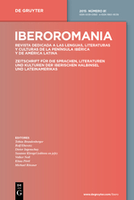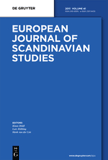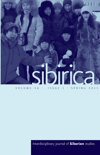
Rusin
Scope & Guideline
Connecting Scholars Through Interdisciplinary Scholarship
Introduction
Aims and Scopes
- Historical Studies:
The journal focuses on the historical narratives and events that have shaped the Rusin identity, including political, social, and cultural histories from various periods. - Linguistic Research:
There is a significant emphasis on the study of the Rusin language and its variants, exploring its evolution, semantics, and its interaction with other languages, particularly in bilingual contexts. - Cultural Identity and Ethnography:
Research on the cultural practices, beliefs, and identity of the Rusin communities is a core area, often examining folklore, traditions, and the socio-political representation of Rusins. - Interethnic Relations:
The journal addresses the interactions and relationships between the Rusins and neighboring ethnic groups, reflecting on historical and contemporary issues of nationalism, identity, and cooperation. - Educational and Textual Analysis:
Studies often include analyses of educational materials, literature, and historical texts that contribute to understanding the transmission of Rusin cultural values and historical narratives.
Trending and Emerging
- Digital Humanities and Big Data:
There is an increasing interest in utilizing digital tools and big data analysis to study historical narratives and cultural representations, reflecting a broader trend in humanities research. - Language Contact and Bilingualism:
Recent themes highlight the complexities of bilingualism and language contact, particularly in the context of Rusin speakers interacting with other ethnic groups, which is becoming a significant area of inquiry. - National Identity and Memory Politics:
The exploration of national identity, particularly in relation to memory politics and historical narratives, is gaining prominence, indicating a growing concern with how identities are constructed and remembered. - Transnational Perspectives:
Research is increasingly looking at Rusins within transnational frameworks, examining their roles and identities in broader geopolitical contexts, which suggests a shift towards more globalized analyses. - Social Media and Contemporary Discourse:
The examination of how Rusin identity and narratives are represented and discussed in social media platforms is emerging as a vital area of study, indicating a response to modern communication trends.
Declining or Waning
- Early Medieval Studies:
Research focusing on the early medieval period, particularly the formative years of the Rusin identity, seems to have decreased, possibly overshadowed by more contemporary topics. - Traditional Folklore Studies:
While folklore remains a part of the discourse, there has been a noticeable decline in papers specifically dedicated to traditional folklore, possibly due to a shift towards modern sociocultural analyses. - Soviet Era Historical Analysis:
Publications that concentrate on the Soviet period's impact on Rusin identity and culture have diminished, indicating a potential shift in focus towards more current socio-political issues. - Art Historical Studies:
Research related to the visual arts and their historical context within the Rusin culture has become less frequent, suggesting a waning interest in this area compared to other forms of cultural analysis.
Similar Journals

BIJDRAGEN TOT DE TAAL- LAND- EN VOLKENKUNDE
Cultivating Scholarly Exchange Across BordersBIJDRAGEN TOT DE TAAL- LAND- EN VOLKENKUNDE, published by BRILL, is an esteemed open-access journal based in the Netherlands that has been a pivotal platform for scholarly discourse since its inception. With an ISSN of 0006-2294 and an E-ISSN of 2213-4379, the journal specializes in the interdisciplinary fields of anthropology, cultural studies, linguistics, and social sciences. This journal enjoys notable rankings, particularly in the 2023 Scopus metrics, where it stands in the 80th percentile for cultural studies and the 75th percentile for language and linguistics, reflecting its significant contributions to these areas of research. Since transitioning to open access in 2013, it has broadened its accessibility, enabling a wider audience of researchers, professionals, and students to engage with critical issues in language, culture, and societal dynamics. With a trajectory extending from 2005 to 2024, BIJDRAGEN TOT DE TAAL- LAND- EN VOLKENKUNDE is not just a repository of knowledge; it is a vibrant forum for scholarly exchange, crucial for advancing understanding in its respective fields.

Journal of New Zealand Studies
Connecting Research with the Pulse of New Zealand SocietyJournal of New Zealand Studies, published by Victoria University of Wellington, Faculty of Law, serves as a pivotal platform for exploration and scholarship pertaining to the cultural, social, and historical dimensions of New Zealand. With its ISSN 1176-306X and E-ISSN 2324-3740, this journal emphasizes interdisciplinary research and aims to promote dialogue between various disciplines within the arts and humanities and social sciences. Despite being categorized in the Q4 quartile for both fields, it represents a unique opportunity for researchers and academics to contribute to, and engage with, the evolving narrative of New Zealand’s identity and its global context. This periodical is crucial for those seeking to delve deeper into the local issues, cultural phenomena, and societal changes that shape New Zealand. It welcomes contributions that push the boundaries of conventional research, thereby enhancing scholarly discourse. For researchers, professionals, and students alike, Journal of New Zealand Studies offers a rich resource for advancing knowledge and fostering an appreciation for New Zealand's diverse scholarly landscape.

IBEROROMANIA
Exploring the Depths of Romance Linguistics and LiteratureIBEROROMANIA, published by WALTER DE GRUYTER GMBH, stands as a pivotal journal in the fields of Linguistics and Language and Literature and Literary Theory. Since its inception in 1969, IBEROROMANIA has facilitated scholarly discourse by providing a platform for cutting-edge research that explores the complexities of Romance languages and their literatures. The journal is recognized for its valuable contributions, currently holding a Q3 quartile ranking in Linguistics and Language and a Q2 ranking in Literature and Literary Theory as of 2023. With its diverse scope spanning several years, including works from 1970 to 2024, IBEROROMANIA is pivotal for researchers, professionals, and students alike, fostering a deeper understanding of Romantic linguistic and literary frameworks. Although it does not provide open access, its impact in the Arts and Humanities is underscored by its Scopus rankings, reflecting a commitment to high-quality scholarship. For those dedicated to exploring the nuances of Romance languages and literature, IBEROROMANIA is an indispensable resource.

Quaestio Rossica
Championing Open Access to Transformative KnowledgeQuaestio Rossica is a prestigious academic journal published by URAL FEDERAL UNIVERSITY that focuses on a broad spectrum of the humanities, encompassing cultural studies, history, linguistics, literature and literary theory, as well as visual and performing arts. With an Open Access model since 2021, it provides unrestricted access to high-quality research articles, fostering a more inclusive platform for scholarly discourse. The journal has notably achieved Q1 rankings in key categories such as Cultural Studies and Literature and Literary Theory, highlighting its impact and relevance. With a commitment to advancing interdisciplinary dialogue, Quaestio Rossica serves as an essential resource for researchers, professionals, and students interested in exploring the rich complexities of human culture and expression. Based in the Russian Federation, it aims to bridge gaps in knowledge across various linguistic and cultural contexts, making its contribution invaluable in today's increasingly globalized academic landscape.

Slavia-Casopis pro Slovanskou Filologii
Connecting Cultures through Slavic Language and LiteratureSlavia-Casopis pro Slovanskou Filologii is an esteemed journal dedicated to the advancement of Slavic philology, published by the SLOVANSKY USTAV AKAD CESKE REPUBLIKY in the heart of the Czech Republic. With its ISSN: 0037-6736, the journal serves as a vital platform for scholarly exchange, embracing a rich academic tradition since its convergence years beginning in 2002. The journal has achieved notable recognition, with a Q3 ranking in Linguistics and Language and a Q2 in Literature and Literary Theory as of 2023, highlighting its contribution to these dynamic fields. Although it does not currently offer open access, its rigorous selection of articles ensures that it remains a crucial resource for researchers and practitioners alike, facilitating a deeper understanding of Slavic languages and literature. Scholars benefit from the journal's extensive research backdrop, enhanced by its current ranks in the Scopus database, underscoring its significant placement within the academic literature landscape. The editorial scope of Slavia promotes innovative inquiries that reflect cultural, historical, and theoretical perspectives endemic to Slavic studies, making it indispensable for professionals, students, and enthusiasts invested in the exploration of Slavic linguistic and literary heritage.

European Journal of Scandinavian Studies
Unveiling the nuances of culture, language, and literature.European Journal of Scandinavian Studies is an esteemed journal published by Walter de Gruyter GmbH, dedicated to advancing scholarship in the fields of Cultural Studies, Linguistics and Language, and Literature and Literary Theory. Since its inception in 2010, the journal has been a pivotal platform for researchers and scholars, showcasing cutting-edge research and critical discussions pertaining to Scandinavian languages and cultures. With an ISSN of 2191-9399 and an E-ISSN of 2191-9402, the journal emphasizes accessibility to impactful academic work, despite its current non-open access model. While the journal is categorized within the Q4 quartile for Cultural Studies and Linguistics/Language, it has shown notable potential in ranking higher in its specialized domains, fostering a growing community of researchers invested in Scandinavian studies. The journal's office is located in Berlin, Germany, further enriching its European scholarly context. As it continues to evolve, the European Journal of Scandinavian Studies serves as a vital resource for academics seeking to engage deeply with the multifaceted aspects of Scandinavian culture and linguistics.

Sibirica-Interdisciplinary journal of Siberian Studies
Bridging Disciplines to Illuminate SiberiaSibirica: Interdisciplinary Journal of Siberian Studies, published by BERGHAHN JOURNALS, is a pioneering open-access journal dedicated to the exploration of Siberian studies through an interdisciplinary lens. Since its launch in 2014, the journal has rapidly established itself as a vital academic resource, evidenced by its impressive rankings in the Scopus database, which include a 75th percentile in History and a 64th percentile in Cultural Studies. Catering to a diverse audience of researchers, professionals, and students, Sibirica engages in critical discussions surrounding the anthropology, culture, history, and social sciences of Siberia, enriching our understanding of this complex region. With a commitment to accessibility since 2020, the journal is poised to foster wider scholarly discourse while offering a platform for innovative research and perspectives. Engaging with Sibirica will not only enhance your academic endeavors but also connect you with a vibrant community dedicated to understanding the multifaceted narratives of Siberia.

Acta Baltico-Slavica
Illuminating Slavic Cultures Through Open Access ResearchActa Baltico-Slavica, an esteemed academic journal published by the Polish Academy of Sciences, Institute of Slavic Studies, serves as a vital platform for the exploration of Slavic cultures, languages, and historical narratives. Since its transition to Open Access in 2014, the journal has fostered inclusivity and accessibility, allowing researchers, professionals, and students to engage with cutting-edge scholarship in the fields of History, Linguistics and Language, and Literature and Literary Theory. With a commendable impact as indicated by its category quartile rankings (Q2 in History and Literature, Q3 in Linguistics), and Scopus rankings reflecting its significance within the academic community, Acta Baltico-Slavica not only contributes to the rich tapestry of scholarship surrounding the Baltic and Slavic regions but also encourages interdisciplinary dialogue. The journal’s commitment to advancing knowledge across its fields of study makes it a prominent destination for scholarly discourse and research inquiry.

NEOPHILOLOGUS
Cultivating Knowledge in Language and Literature Since 1916NEOPHILOLOGUS, published by Springer, stands as a pivotal journal in the fields of Linguistics and Language as well as Literature and Literary Theory. With an illustrious history dating back to 1916 and continuing through various phases until 2024, this journal has entrenched itself as a crucial platform for scholarly discussion and research dissemination. NEOPHILOLOGUS is recognized for its high academic standards, as evidenced by its impressive category quartiles, ranking in the Q2 tier for Linguistics and Language and Q1 for Literature and Literary Theory as of 2023. Notably, it ranks in the 81st percentile for Arts and Humanities in the Scopus database, underscoring its significant contribution to the humanities discourse. While the journal does not currently offer open access options, it remains a valuable resource for researchers, professionals, and students seeking in-depth analyses and insights within its specialized domains. Based in Dordrecht, Netherlands, NEOPHILOLOGUS invites contributions that advance our understanding of linguistic and literary phenomena, ensuring its relevance and impact in these dynamic fields.

Epohi
Illuminating the Intersection of Past and Present.Epohi is a distinguished academic journal published by the St Cyril and St Methodius University Publishing House, focusing on interdisciplinary research in the fields of social sciences and humanities. With its ISSN 1310-2141 and E-ISSN 2534-8418, the journal aims to provide a platform for innovative thought and scholarly discourse, bridging gaps between historical perspectives and contemporary issues. While currently exploring open access options to enhance accessibility, Epohi remains a pivotal resource for researchers, professionals, and students seeking to contribute to and engage with cutting-edge research. Situated in the serene locale of Veliko Tarnovo, Bulgaria, this journal not only enriches the academic landscape but also fosters collaboration and professional growth in the broader scholarly community.